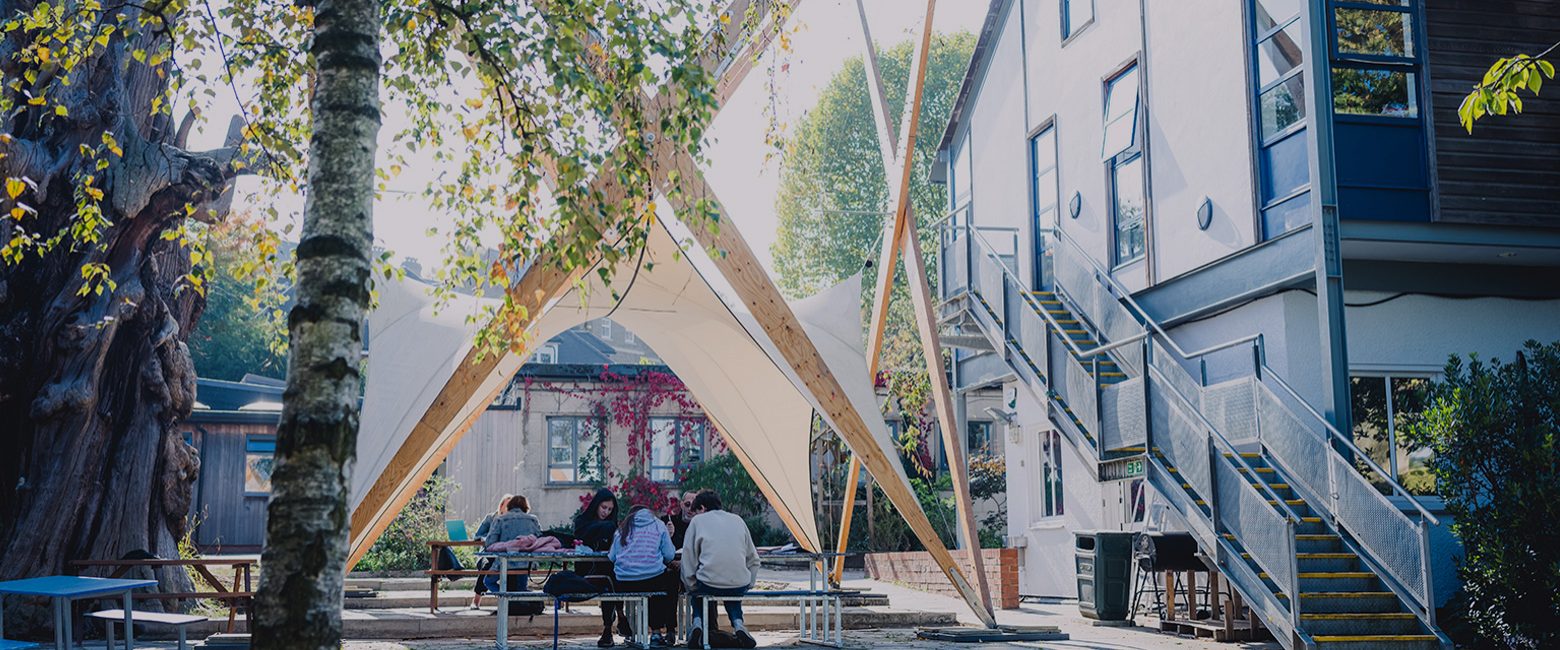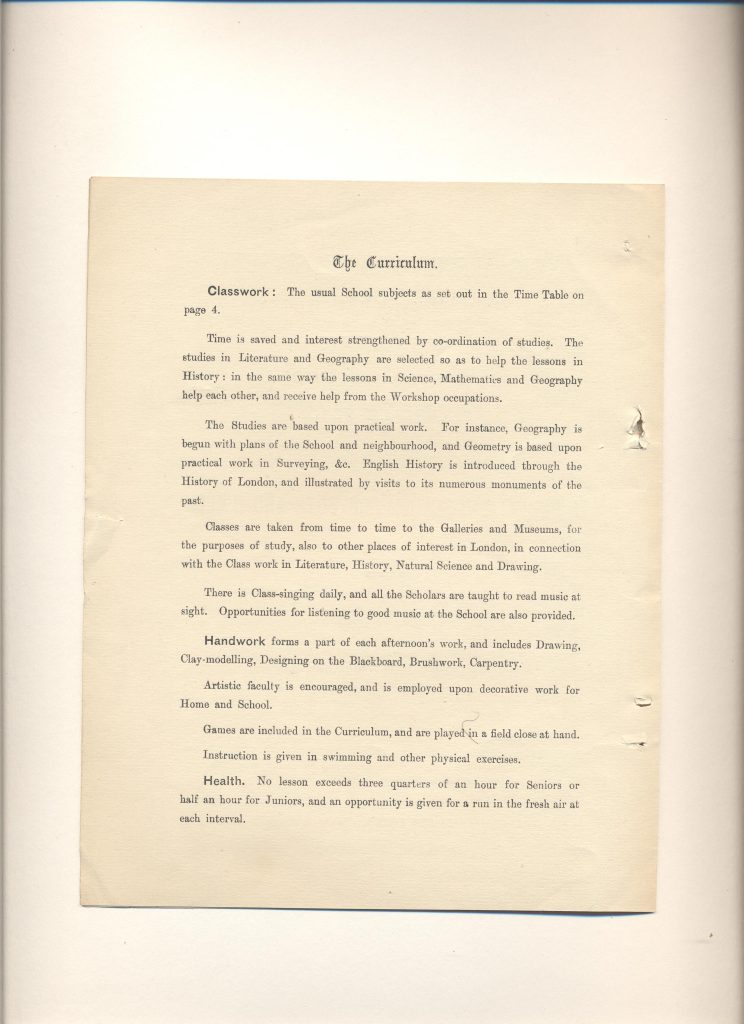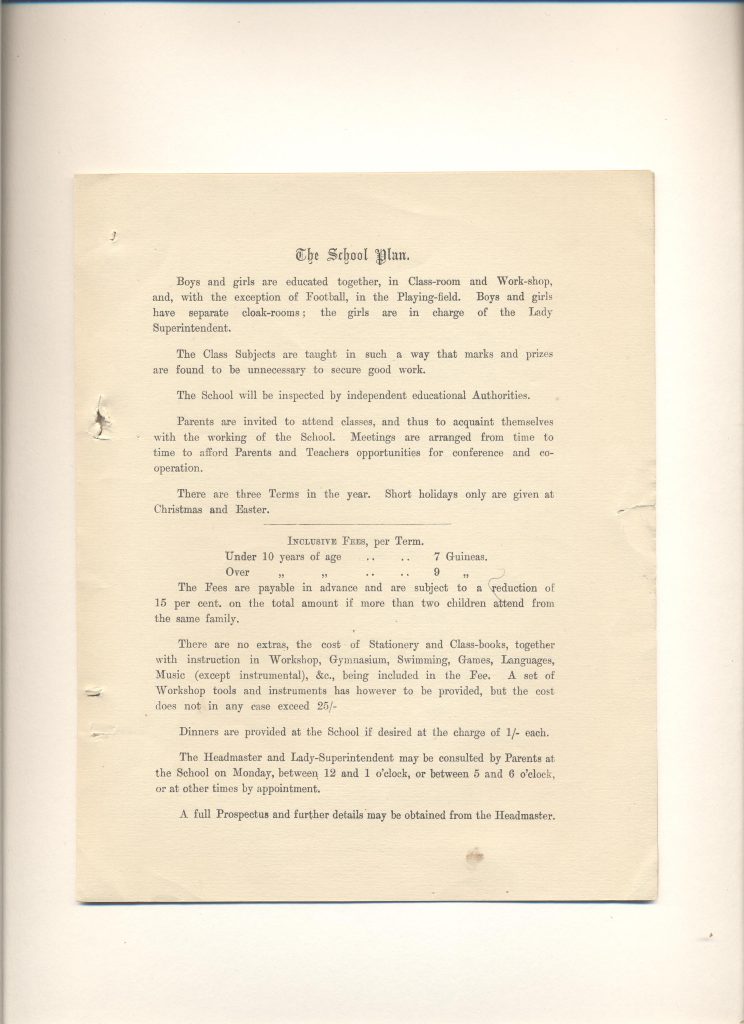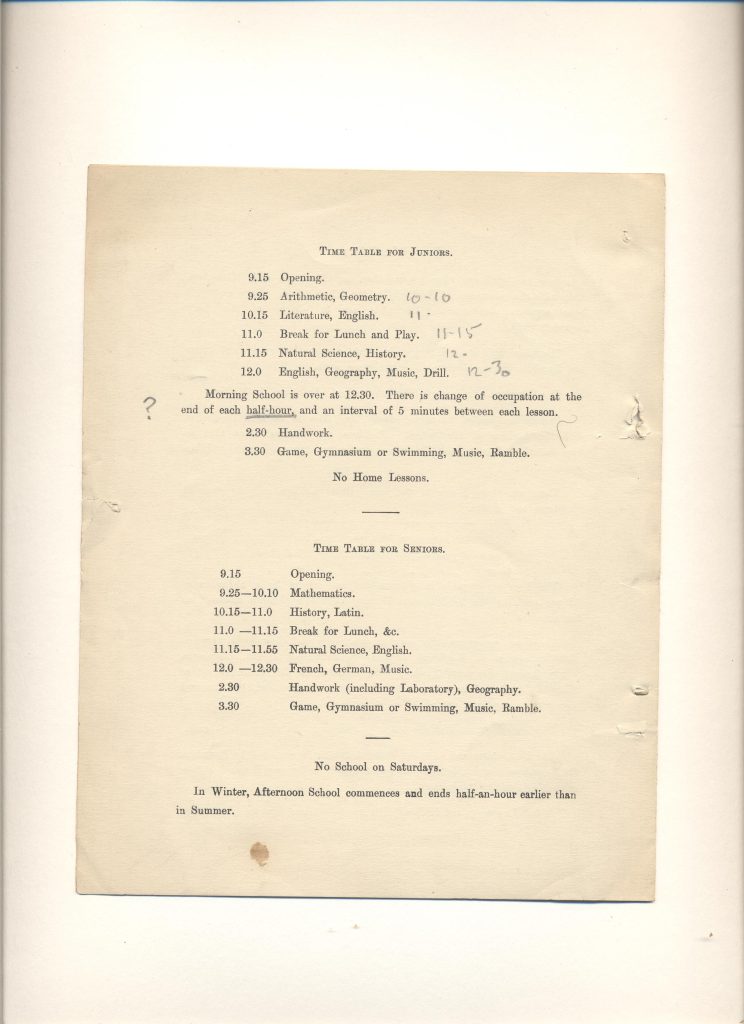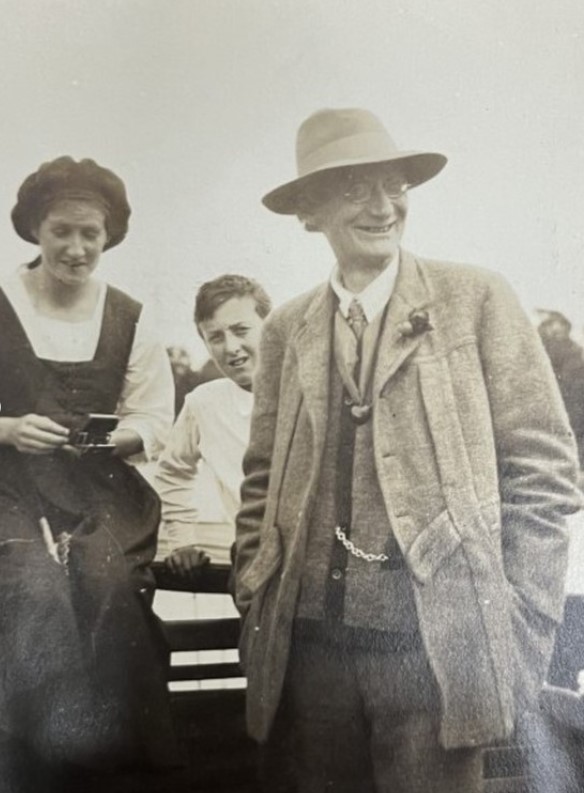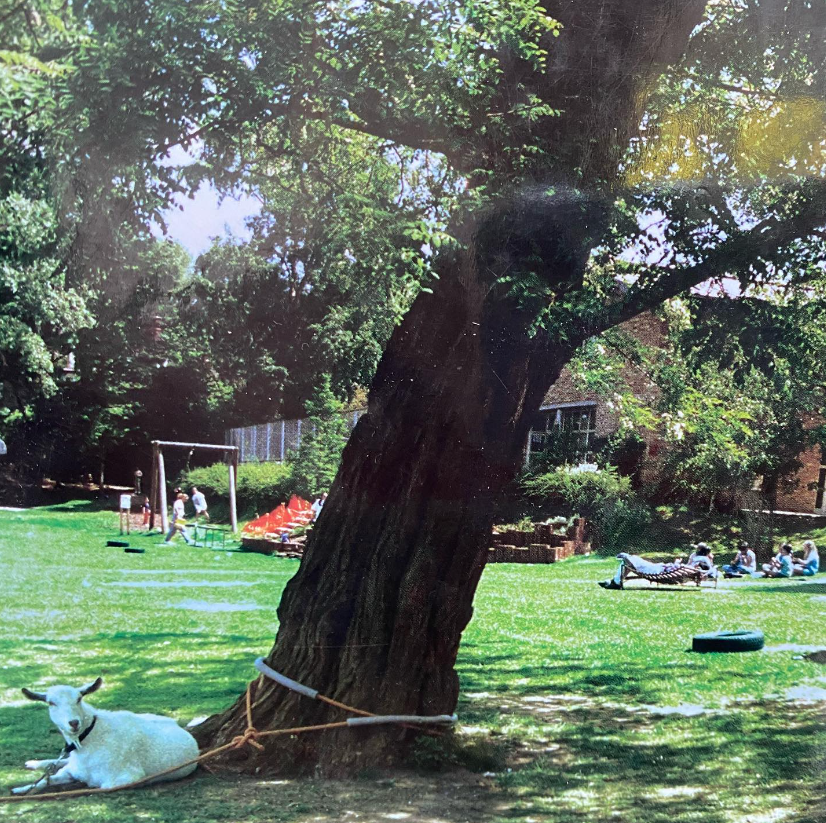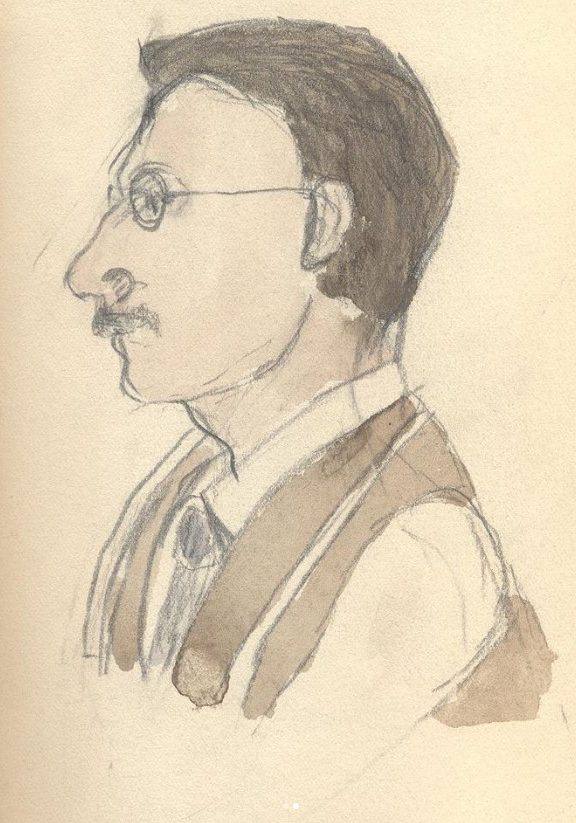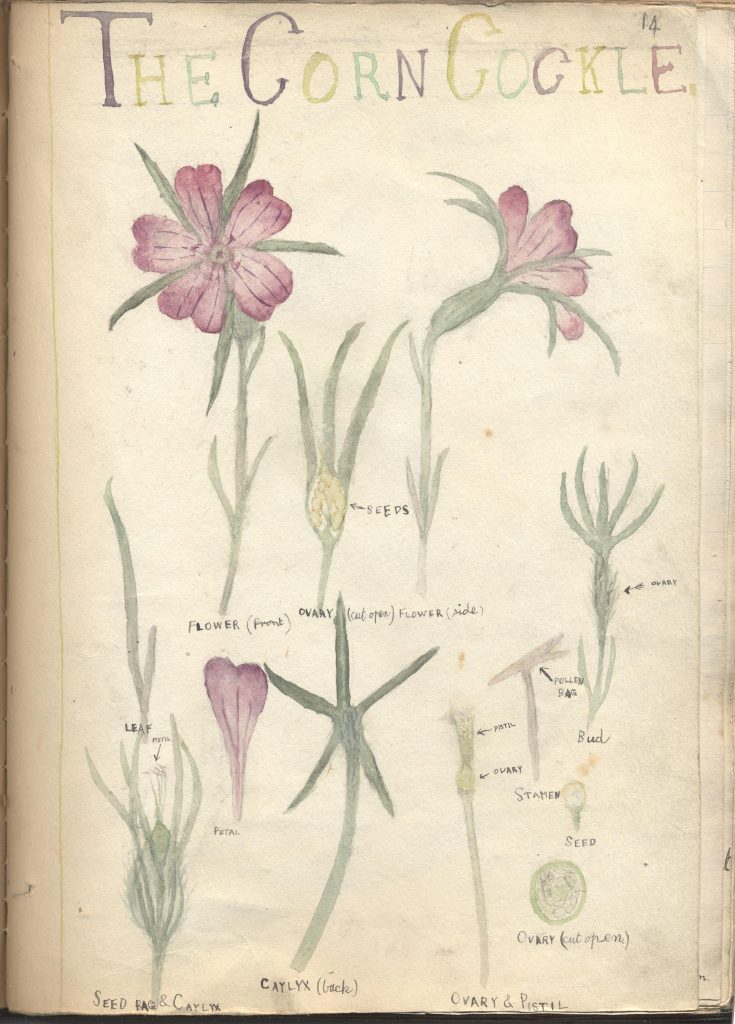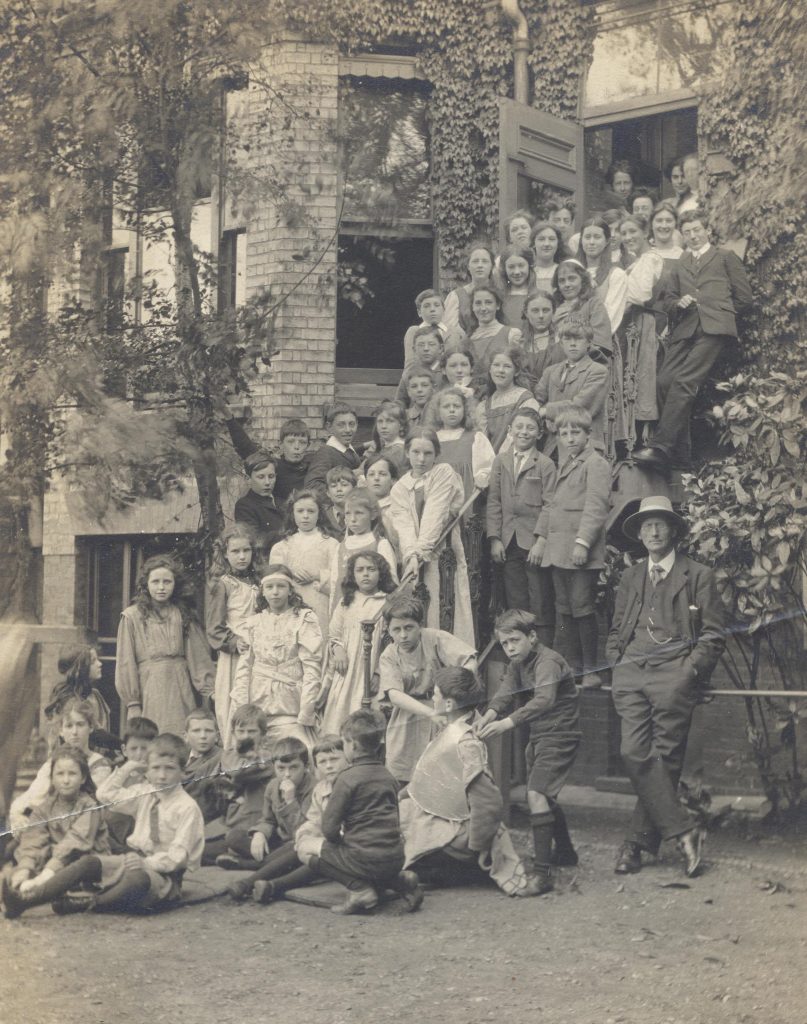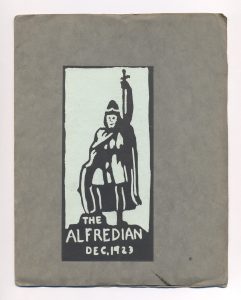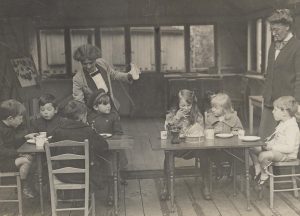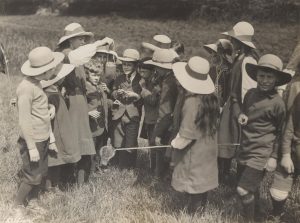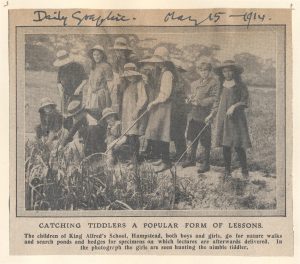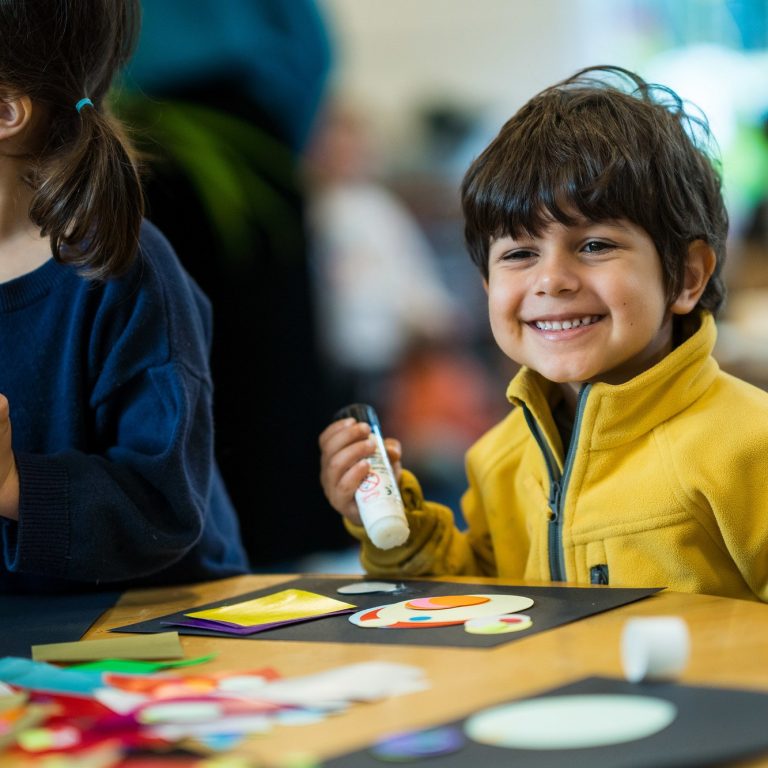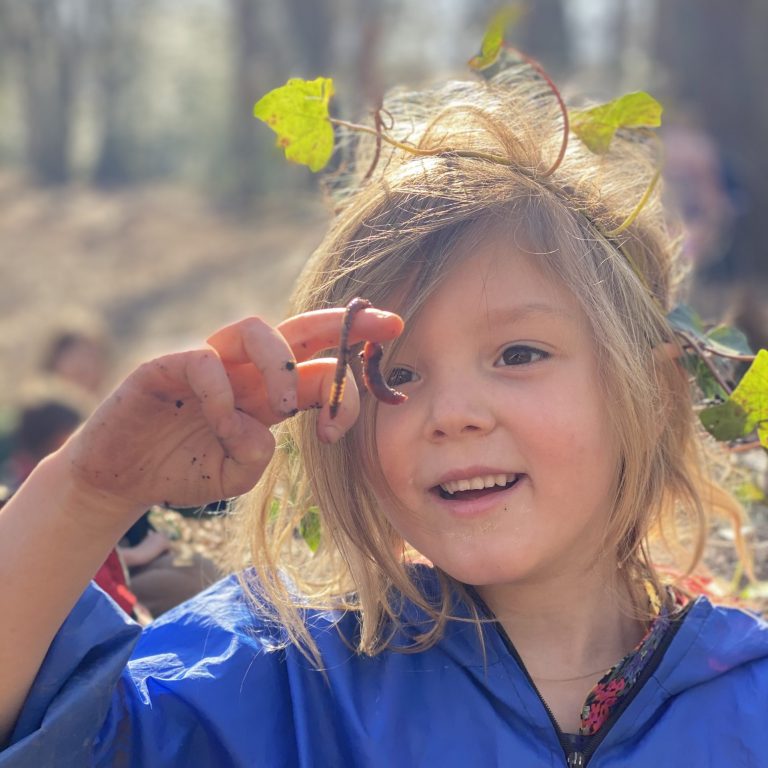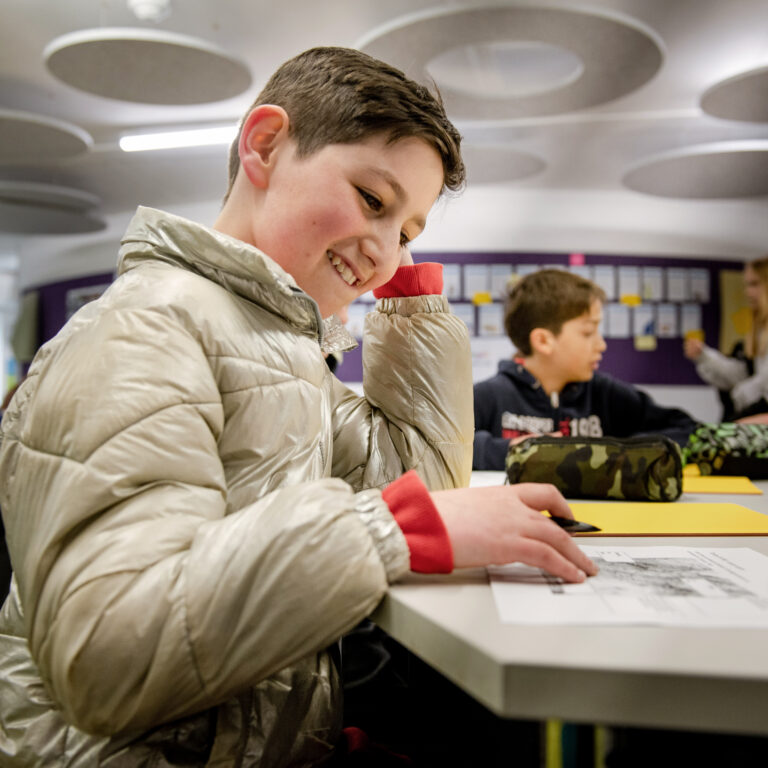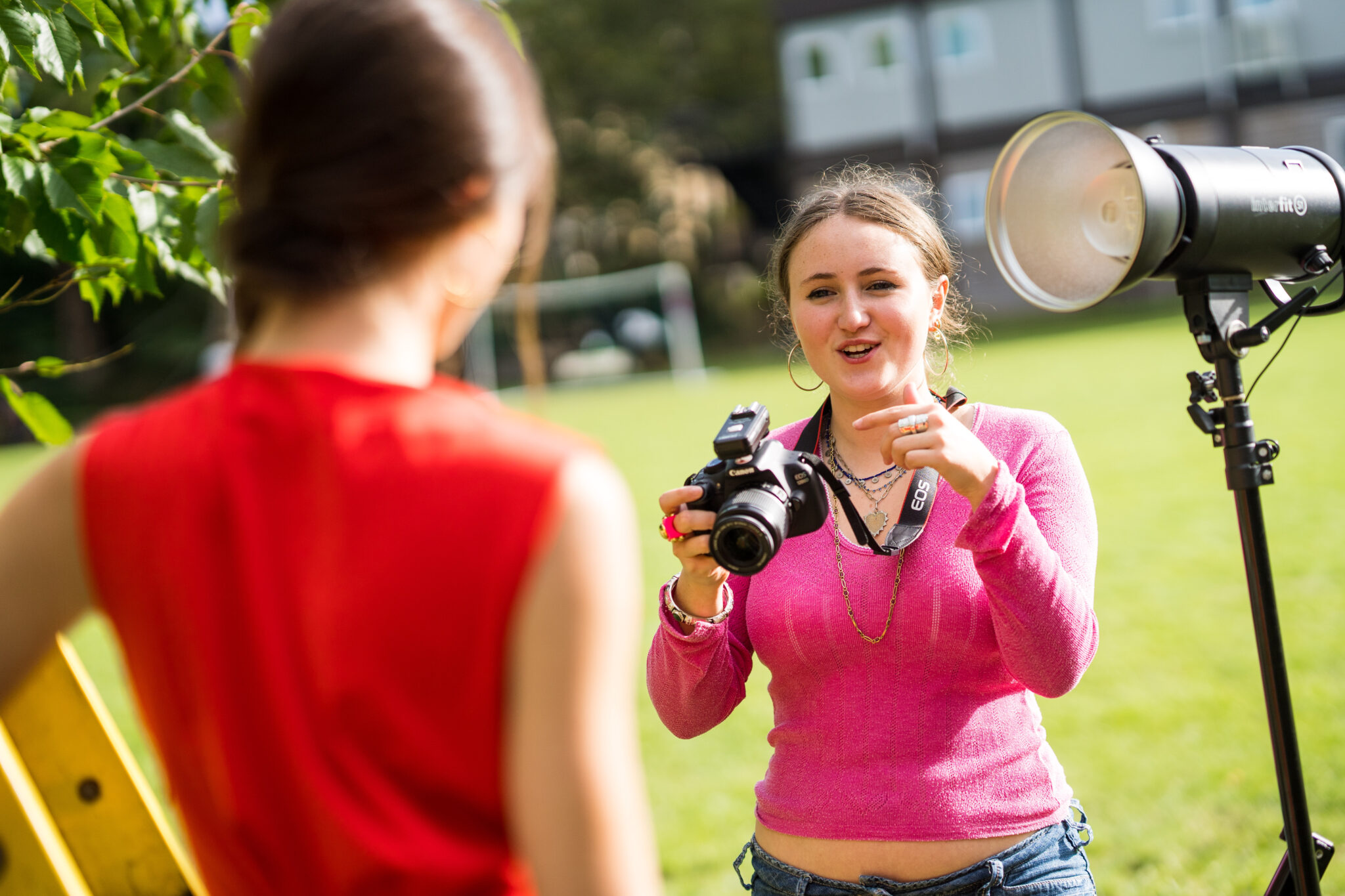KAS In 125 Artefacts
It is a landmark year for KAS in 2023… it’s our 125th anniversary!
The King Alfred School has played an important part in so many people’s lives and throughout our anniversary year we will be reflecting on the school’s impact as well as looking forward to all the exciting plans and developments that lie ahead for our community – ‘Honouring our Past; Inspiring our Future’.
On the theme of honouring our past, our very own archivist Sheila has begun lifting the lid on KAS over the last 125 years. Through Instagram and Twitter posts, Sheila is telling the history of KAS in 125 artefacts.
Follow king_alfred_archive on Instagram and @KASArchives on Twitter to discover for yourself little-known stories about the School.
Below is just a taste of what you will find…
Proposal For A New School
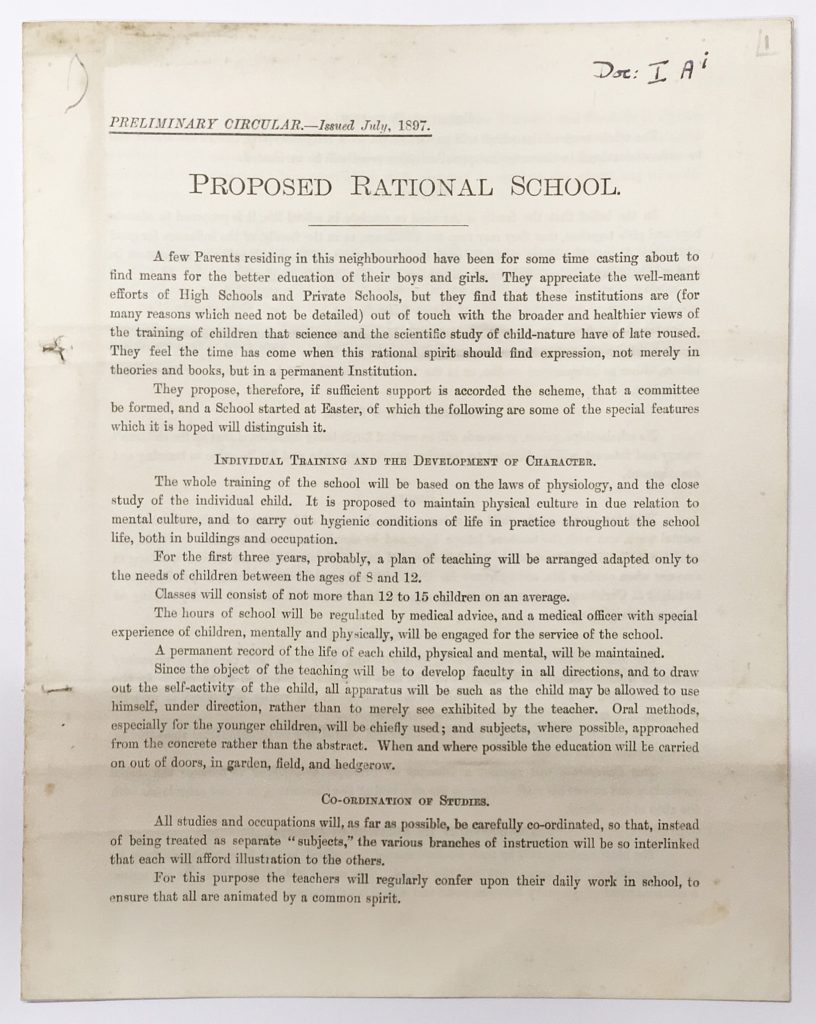
Proposal For A New School
We begin our look at the history of KAS in 125 Artefacts with the document which started it all.
This is the original 1897 ‘Proposed Rational School’ circular setting out the vision and ethos essential to The King Alfred School’s approach to education.
As a school, KAS retains many of the core values set out in this document today.
As an example our current 6-8 curriculum, which includes interdisciplinary learning as a core element, could be described perfectly by the words in this original proposal for the school in 1897: “All studies and occupations will, as far as possible, be carefully co-ordinated, so that, instead of being treated as separate “subjects,” the various branches of instruction will be so interlinked that each will afford illustration to the others.”
The First Register
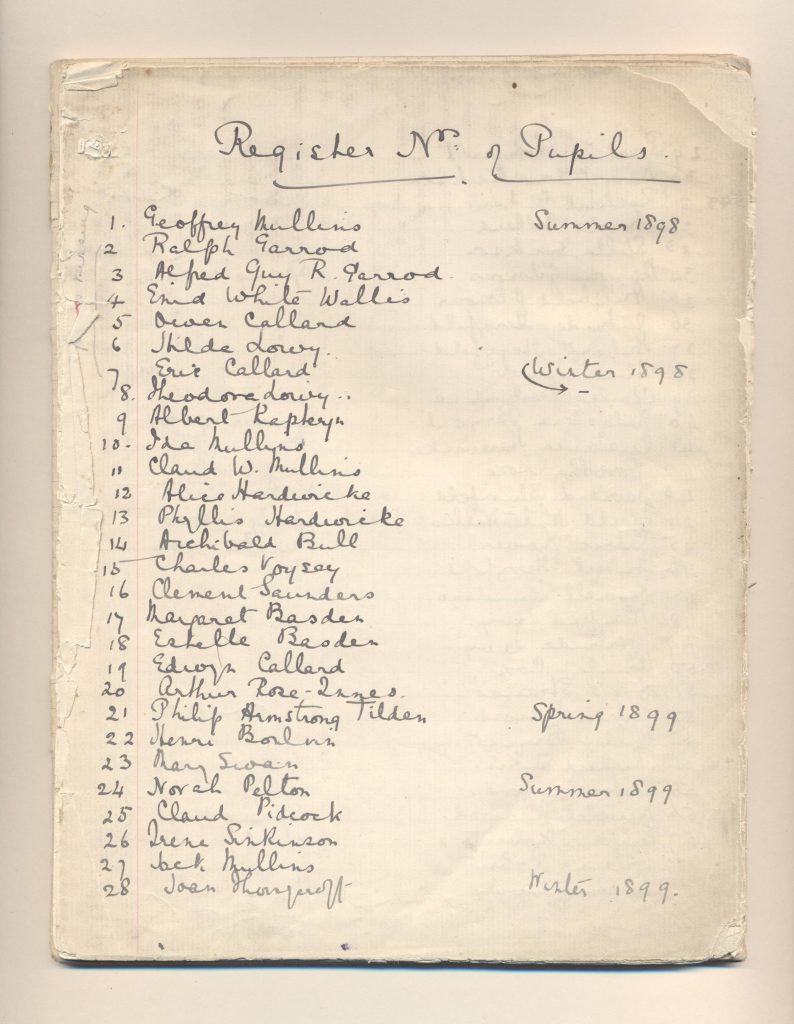
The First Register
The King Alfred School opened 24 June 1898. Women’s suffrage campaigner Millicent Fawcett, founder of the National Union of Women’s Suffrage Societies (NUWSS), took part in the inaugural ceremony.
The first register lists seven pupils, five boys and two girls, aged seven to nine.
The school stood out as it was coeducational, with girls and boys learning together, from the start. This commitment to gender equality may have been part of why reform minded people such as Fawcett took an interest in the new school.
The First Head
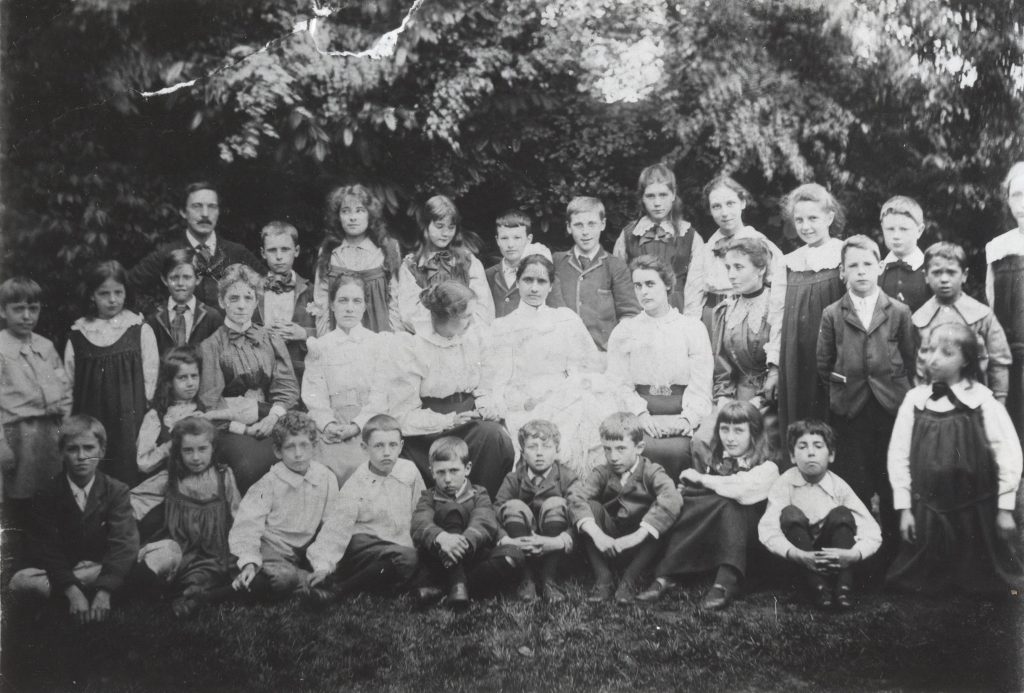
The First Head
The King Alfred School’s first Headmaster Charles E Rice is shown here with students circa 1899. Rice came to KAS from Bedales, where he served as assistant master and taught science plus a diversity of subjects ranging from English to Woodwork. His experience applying exploratory, experiential and experimental educational practices was well suited to KAS’s ethos.
Rice was tasked with delivering the progressive framework for “Educational Science” devised by the King Alfred School Society (KASS) in collaboration with leading educationalist Joseph John Findlay. The resulting curriculum met the learning needs of students in an age of change leading up to the turn of the century. It also remained true to the founders’ vision of a happy, child centered approach to education.

Proposal For A New School
We begin our look at the history of KAS in 125 Artefacts with the document which started it all.
This is the original 1897 ‘Proposed Rational School’ circular setting out the vision and ethos essential to The King Alfred School’s approach to education.
As a school, KAS retains many of the core values set out in this document today.
As an example our current 6-8 curriculum, which includes interdisciplinary learning as a core element, could be described perfectly by the words in this original proposal for the school in 1897: “All studies and occupations will, as far as possible, be carefully co-ordinated, so that, instead of being treated as separate “subjects,” the various branches of instruction will be so interlinked that each will afford illustration to the others.”

The First Register
The King Alfred School opened 24 June 1898. Women’s suffrage campaigner Millicent Fawcett, founder of the National Union of Women’s Suffrage Societies (NUWSS), took part in the inaugural ceremony.
The first register lists seven pupils, five boys and two girls, aged seven to nine.
The school stood out as it was coeducational, with girls and boys learning together, from the start. This commitment to gender equality may have been part of why reform minded people such as Fawcett took an interest in the new school.

The First Head
The King Alfred School’s first Headmaster Charles E Rice is shown here with students circa 1899. Rice came to KAS from Bedales, where he served as assistant master and taught science plus a diversity of subjects ranging from English to Woodwork. His experience applying exploratory, experiential and experimental educational practices was well suited to KAS’s ethos.
Rice was tasked with delivering the progressive framework for “Educational Science” devised by the King Alfred School Society (KASS) in collaboration with leading educationalist Joseph John Findlay. The resulting curriculum met the learning needs of students in an age of change leading up to the turn of the century. It also remained true to the founders’ vision of a happy, child centered approach to education.
School Prospectus 1900
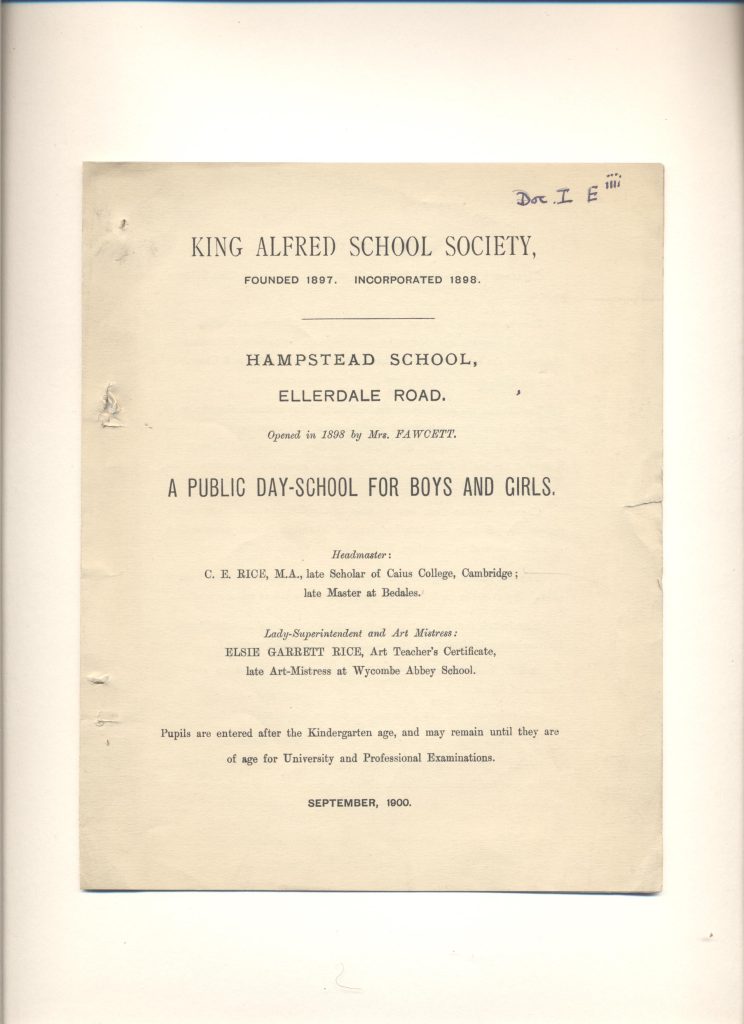
School Prospectus 1900
The King Alfred School Prospectus for 1900 provides an overview of the educational experience parents and students could expect.
Compare it to our current prospectus here.
Co-ordinated studies was a unique feature approaching traditional subjects from an interdisciplinary perspective. See the timetable on page 4 for a glimpse of a Junior and Senior student’s day at KAS. In Winter, classes ended 30 mins earlier than in Summer. “No Home Lessons” reflects a commitment to family and leisure time outside of school.
The Russell Album
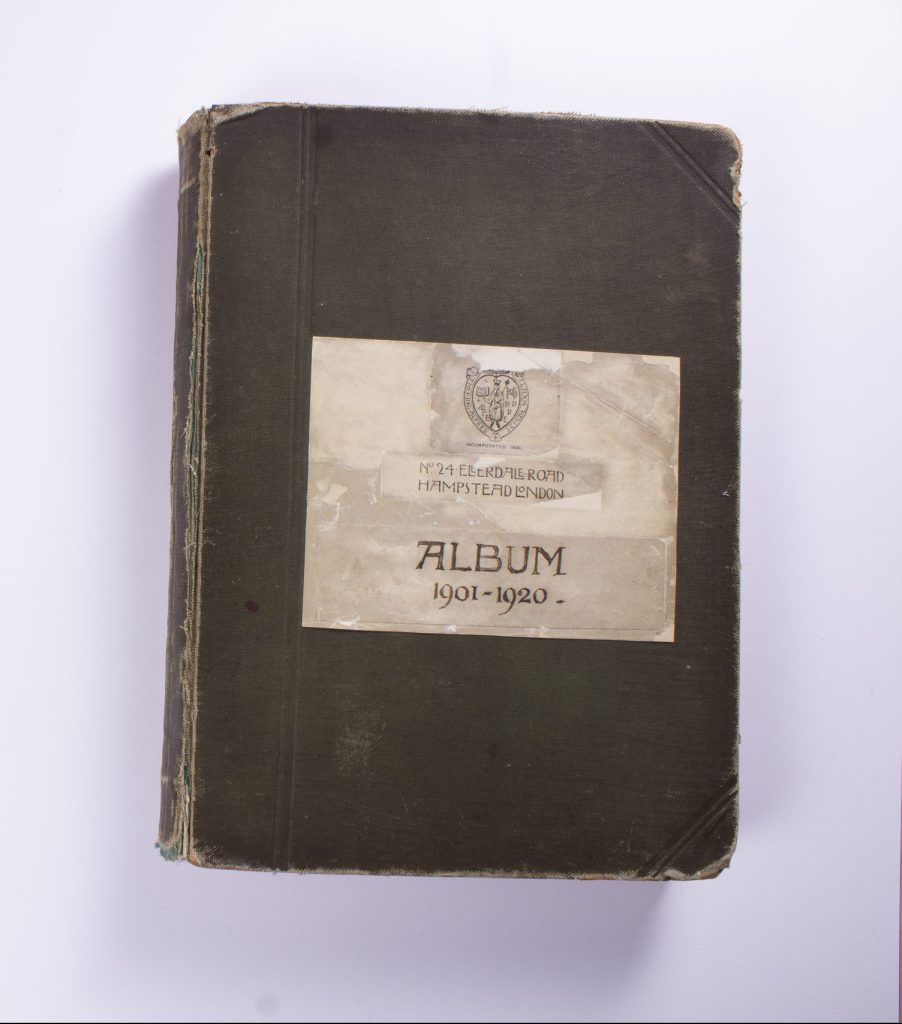
The Russell Album
When John Russell was appointed KAS headmaster in 1901 he knew he was joining an educational institution that was making history. Russell made it his duty to document the school’s early days – in many ways he was our first archivist. “The Russell Album” shown here captured school life and his place in it from 1901-1920.
Russell embodied the KAS ethos and strove for a balance between providing a progressive, child centered educational experience and meeting traditional measures of academic success including exam results and progression to university. JR, as he was affectionately known, developed a strong bond with his students many of whom continued to correspond with him after graduating. (We have his letters in our collection too!)
The final pages of The Russell Album show Russell in a jolly mood on a boating trip with his students.
The Goat Rope
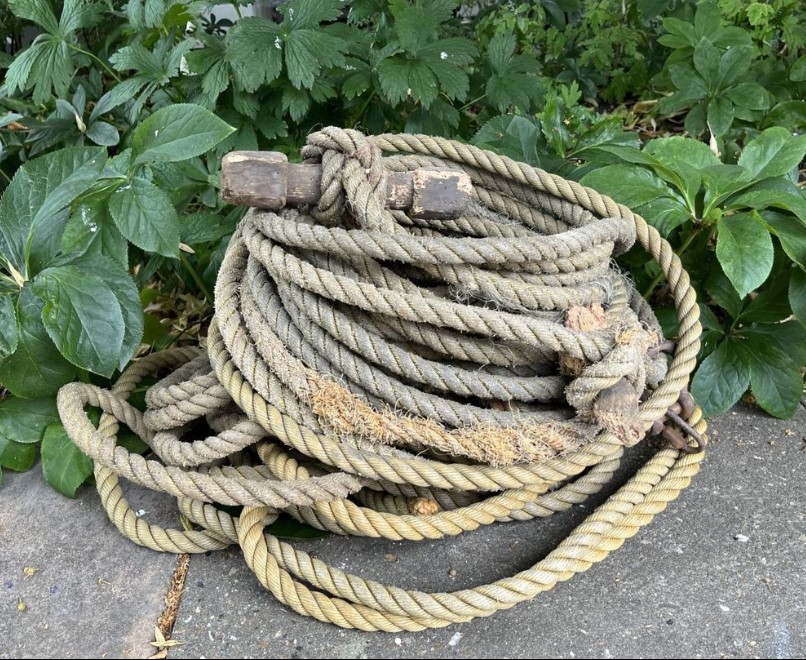
The Goat Rope
This is exactly what it says it is – a rope used to tie up the school goats when they weren’t allowed to roam the field.
Former students may remember Dulcie, Daisy, Dolly and Billy. The goats roamed the school field and even starred in a pantomime! We no longer have a school goat, but the Lower School Farm remains a vital part of our learning environment.

School Prospectus 1900
The King Alfred School Prospectus for 1900 provides an overview of the educational experience parents and students could expect.
Compare it to our current prospectus here.
Co-ordinated studies was a unique feature approaching traditional subjects from an interdisciplinary perspective. See the timetable on page 4 for a glimpse of a Junior and Senior student’s day at KAS. In Winter, classes ended 30 mins earlier than in Summer. “No Home Lessons” reflects a commitment to family and leisure time outside of school.

The Russell Album
When John Russell was appointed KAS headmaster in 1901 he knew he was joining an educational institution that was making history. Russell made it his duty to document the school’s early days – in many ways he was our first archivist. “The Russell Album” shown here captured school life and his place in it from 1901-1920.
Russell embodied the KAS ethos and strove for a balance between providing a progressive, child centered educational experience and meeting traditional measures of academic success including exam results and progression to university. JR, as he was affectionately known, developed a strong bond with his students many of whom continued to correspond with him after graduating. (We have his letters in our collection too!)
The final pages of The Russell Album show Russell in a jolly mood on a boating trip with his students.

The Goat Rope
This is exactly what it says it is – a rope used to tie up the school goats when they weren’t allowed to roam the field.
Former students may remember Dulcie, Daisy, Dolly and Billy. The goats roamed the school field and even starred in a pantomime! We no longer have a school goat, but the Lower School Farm remains a vital part of our learning environment.
An Inspirational Teacher
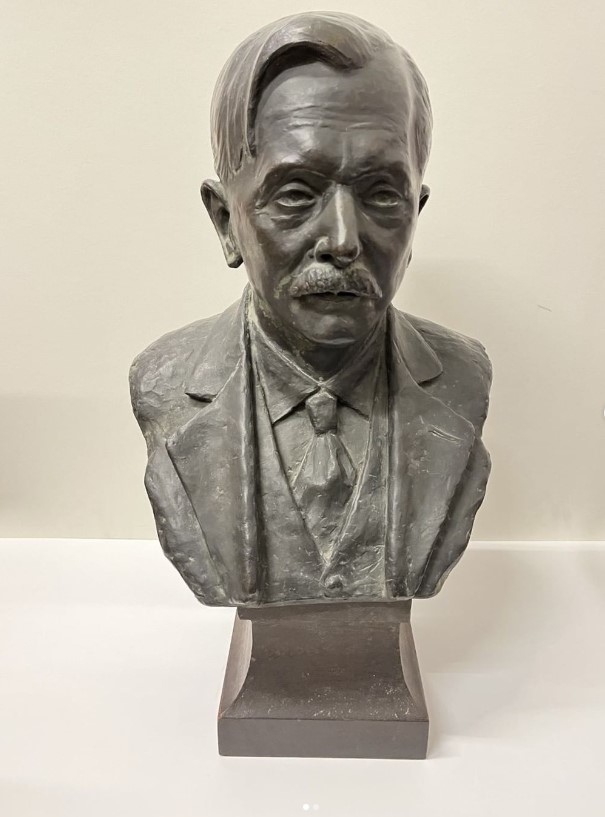
An Inspirational Teacher
The KAS Archives holds more than just documents. This is a bronze bust of George Chester Earle, who joined the school in 1903. Earle was a favourite teacher, known for his interdisciplinary approach mixing English with woodwork and inspiring creative thinking.
Student Rosalind Thornycroft recalled, “Keats and Shakespeare lines flew about with the woodshavings and in his white carpenter’s apron and flashing glasses he actively demonstrated the mystery of spirit and material made one.”
The bust was made by Montenegrin sculptor Yanko Brayovitch shortly after Earle’s death in 1949. It was commissioned by Earle’s partner Eleanor Farjeon, an accomplished author who is best known for her children’s literature and for writing the hymn “Morning has Broken.” Earle’s granddaughter donated the beautiful piece to our collection.
The archive also holds this charming student sketch of Earle, which echoes the features captured in Brayovitch’s sculpture.
Early School Magazines
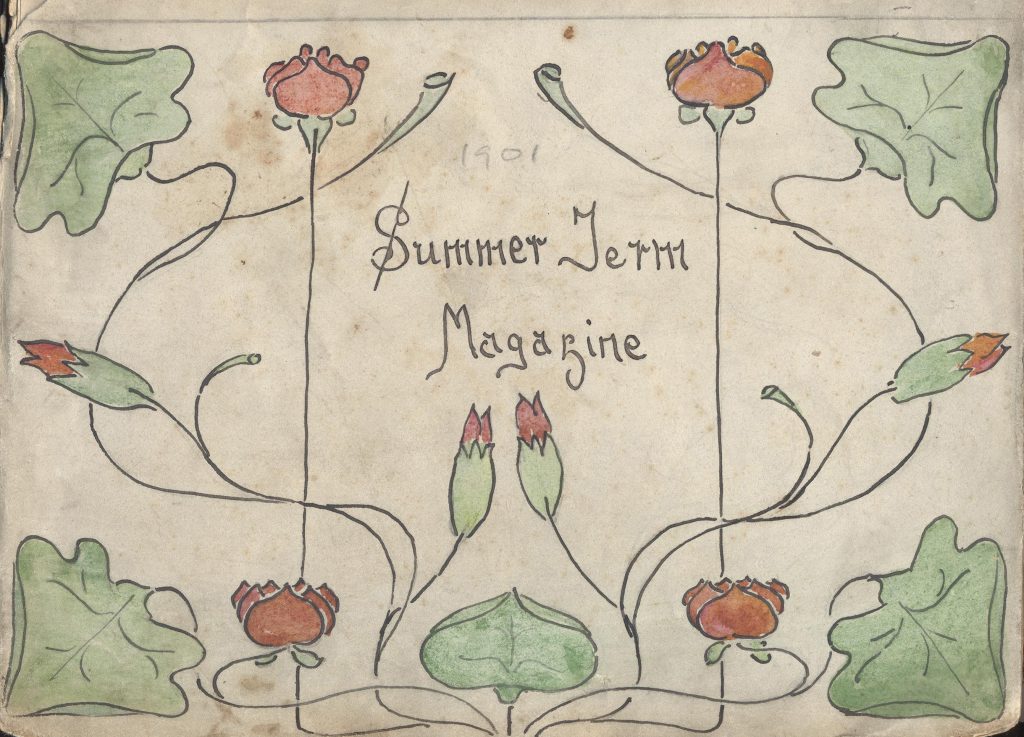
Early School Magazines
King Alfred School has a long tradition of student produced magazines. The first editions were hand written and contained original illustrations. The pages were bound into an annual, the only copy of which was kept by the headmaster. This is a cover from 1901 showing a beautiful illustration with echos of Charles Rennie Mackintosh.
Here is another nature-inspired illustration from inside the 1899 magazine by Mary Swan:
The First School Building
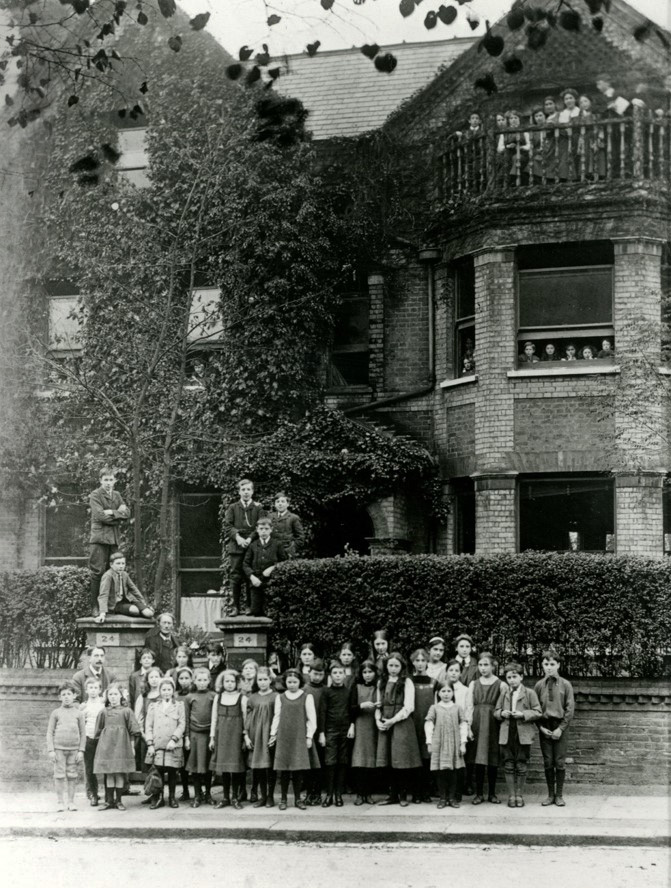
The First School Building
This fantastic photo is of 24 Ellerdale Road, Hampstead – the original school site. With students and teachers gathered outside it shows the smaller size of the school in it’s early days.
Sheila, our KAS Archivist got on her bike to check it out, taking historic photos for identifying purposes!
This image shows students circa 1909 pouring out of the building with Headmaster John Russell posed casually on the right. In 1910 KAS expanded into the adjacent house.
Although the building has been modernised, it bears a striking resemblance to the place KAS once called home.

An Inspirational Teacher
The KAS Archives holds more than just documents. This is a bronze bust of George Chester Earle, who joined the school in 1903. Earle was a favourite teacher, known for his interdisciplinary approach mixing English with woodwork and inspiring creative thinking.
Student Rosalind Thornycroft recalled, “Keats and Shakespeare lines flew about with the woodshavings and in his white carpenter’s apron and flashing glasses he actively demonstrated the mystery of spirit and material made one.”
The bust was made by Montenegrin sculptor Yanko Brayovitch shortly after Earle’s death in 1949. It was commissioned by Earle’s partner Eleanor Farjeon, an accomplished author who is best known for her children’s literature and for writing the hymn “Morning has Broken.” Earle’s granddaughter donated the beautiful piece to our collection.
The archive also holds this charming student sketch of Earle, which echoes the features captured in Brayovitch’s sculpture.

Early School Magazines
King Alfred School has a long tradition of student produced magazines. The first editions were hand written and contained original illustrations. The pages were bound into an annual, the only copy of which was kept by the headmaster. This is a cover from 1901 showing a beautiful illustration with echos of Charles Rennie Mackintosh.
Here is another nature-inspired illustration from inside the 1899 magazine by Mary Swan:

The First School Building
This fantastic photo is of 24 Ellerdale Road, Hampstead – the original school site. With students and teachers gathered outside it shows the smaller size of the school in it’s early days.
Sheila, our KAS Archivist got on her bike to check it out, taking historic photos for identifying purposes!
This image shows students circa 1909 pouring out of the building with Headmaster John Russell posed casually on the right. In 1910 KAS expanded into the adjacent house.
Although the building has been modernised, it bears a striking resemblance to the place KAS once called home.
The Alfredian Magazine
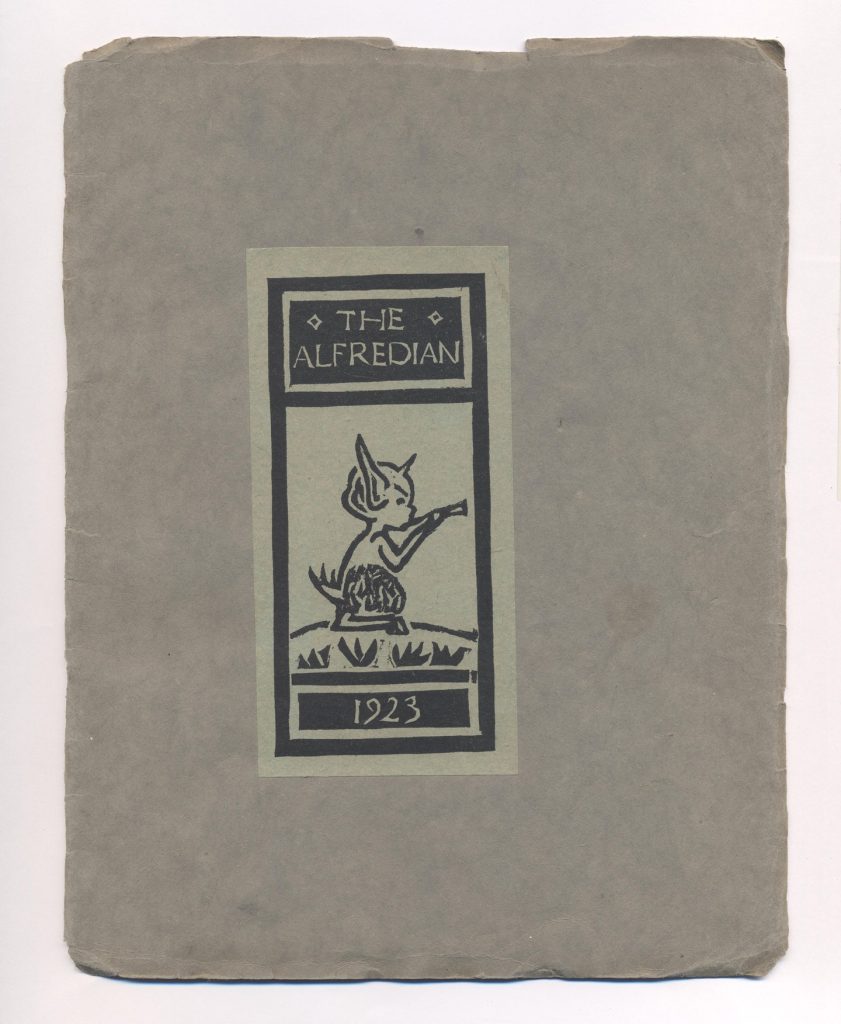
The Alfredian Magazine
In 1923 The KAS Magazine was relaunched as “The Alfredian” with beautifully printed covers. The covers and pages were produced on-site in The KAS Print Room.
The School Crest
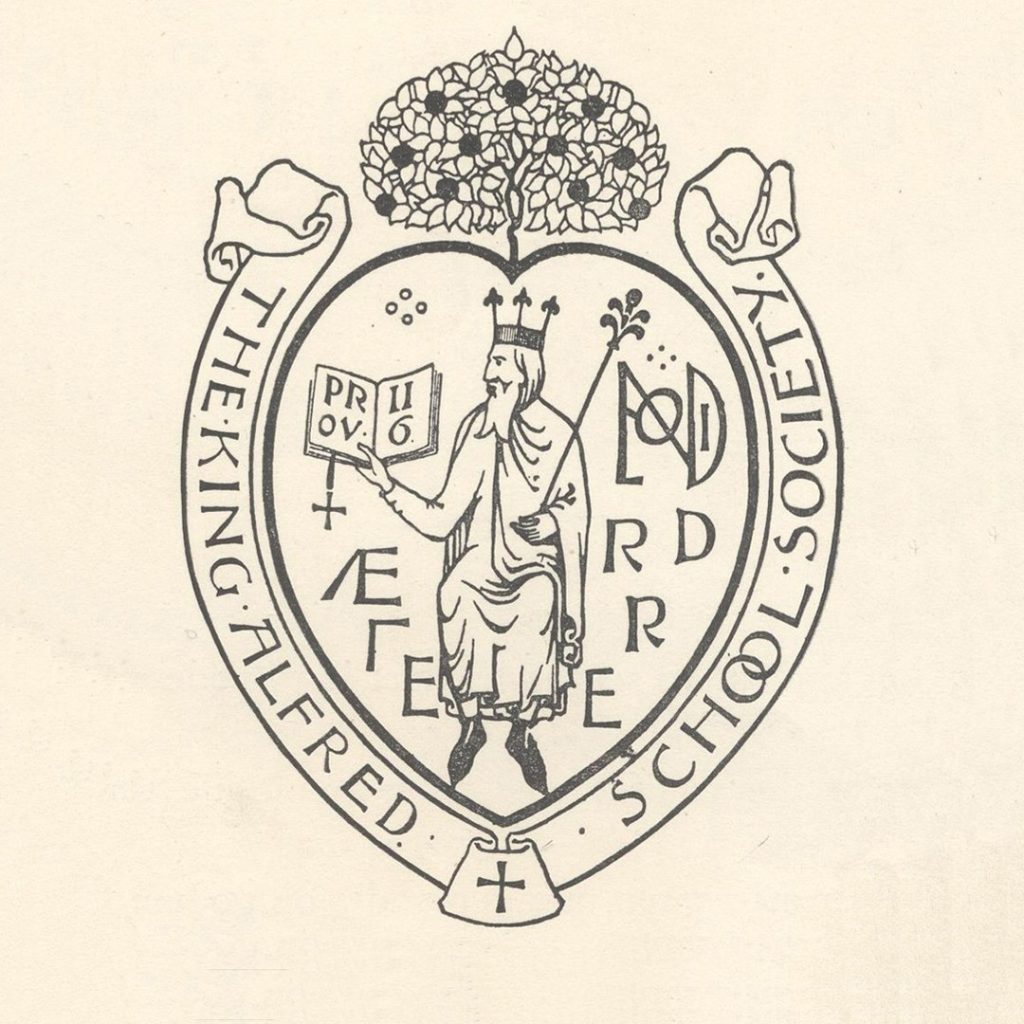
The School Crest
Architect and designer CFA Voysey designed the King Alfred School crest in 1898. King Alfred the Great appears in a heart with the tree of knowledge springing from it. The initials surrounding Alfred were used on the coins of his day. He holds a bible open to Proverbs II:6, “For the Lord giveth wisdom. Out of his mouth comes knowledge and understanding.”
Voysey later simplified the design to show Alfred’s stylised crown enclosed in a heart sprouting a sapling and including the motto “Ex Corde Vita”, out of the heart springs life. The V&A holds the design for an arts and crafts style stained glass window in this pattern dated 1907 and signed by Voysey.
Voysey’s children attended KAS. He designed several buildings for KAS which were never built but inspired the school’s architectural vision.
The Garden School
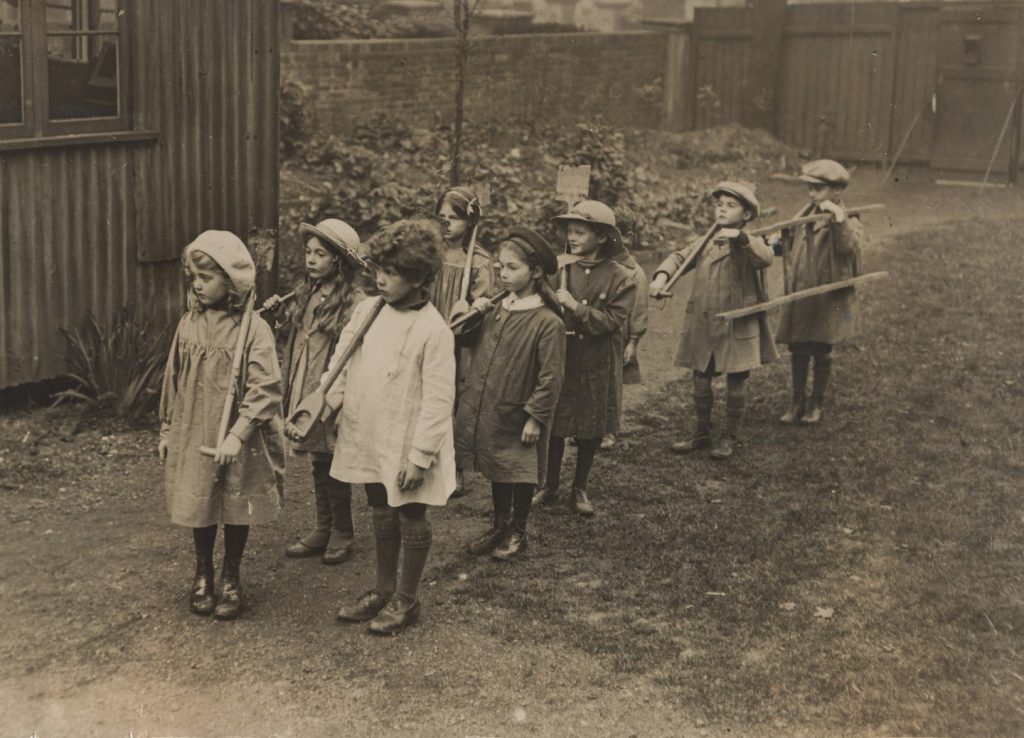
The Garden School
In May 1910, KAS opened its first Garden School for pre-school and reception age children.
The prospectus noted “All work and play is carried out either in the open meadow or under shady trees, but for use in inclement weather there is a shelter, the whole front of which can be thrown open to the south.”
The approach of the new school emphasized play and self-directed learning as essential to child development.
A report by the Chief Medical Officer of the Board of Education noted that the open-air environment “stimulated mental alertness” and eliminating epidemics and infectious disease among staff or students.

The Alfredian Magazine
In 1923 The KAS Magazine was relaunched as “The Alfredian” with beautifully printed covers. The covers and pages were produced on-site in The KAS Print Room.

The School Crest
Architect and designer CFA Voysey designed the King Alfred School crest in 1898. King Alfred the Great appears in a heart with the tree of knowledge springing from it. The initials surrounding Alfred were used on the coins of his day. He holds a bible open to Proverbs II:6, “For the Lord giveth wisdom. Out of his mouth comes knowledge and understanding.”
Voysey later simplified the design to show Alfred’s stylised crown enclosed in a heart sprouting a sapling and including the motto “Ex Corde Vita”, out of the heart springs life. The V&A holds the design for an arts and crafts style stained glass window in this pattern dated 1907 and signed by Voysey.
Voysey’s children attended KAS. He designed several buildings for KAS which were never built but inspired the school’s architectural vision.

The Garden School
In May 1910, KAS opened its first Garden School for pre-school and reception age children.
The prospectus noted “All work and play is carried out either in the open meadow or under shady trees, but for use in inclement weather there is a shelter, the whole front of which can be thrown open to the south.”
The approach of the new school emphasized play and self-directed learning as essential to child development.
A report by the Chief Medical Officer of the Board of Education noted that the open-air environment “stimulated mental alertness” and eliminating epidemics and infectious disease among staff or students.
School Play

School Play
Drama and performances have always been a central part of student life at KAS. In 1912, the school play was Odin. If you look carefully, you can see the school motto “Ex Corde Vita” on the stage.
Outdoor Learning
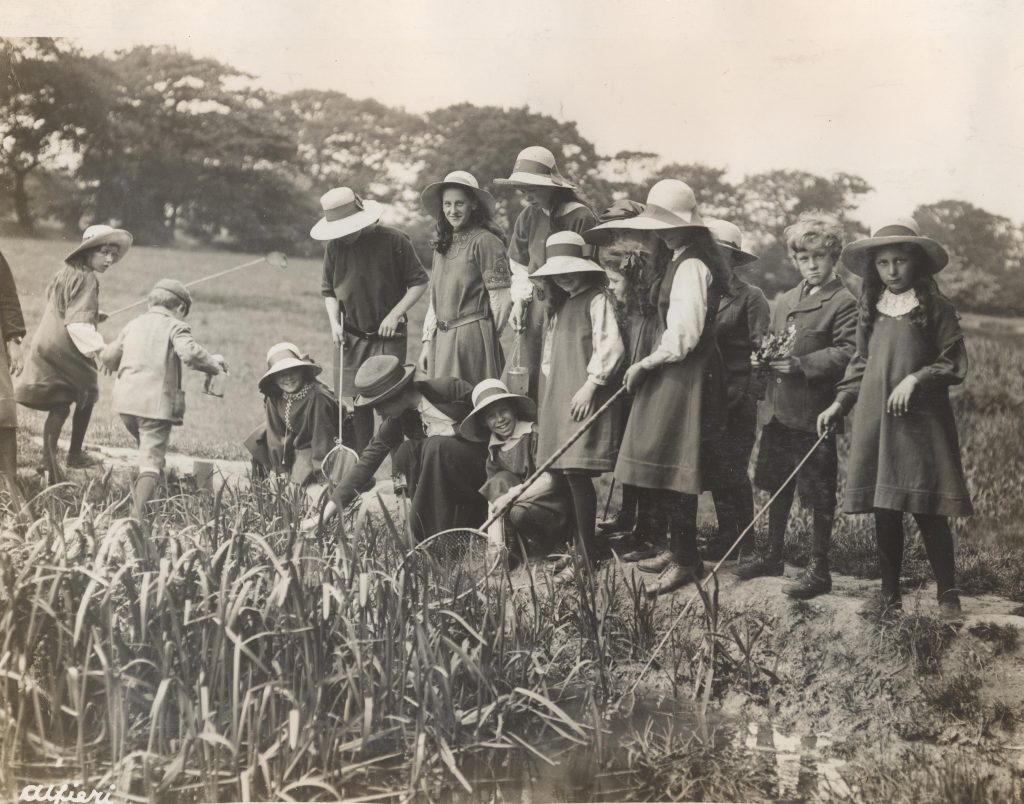
Outdoor Learning
Outdoor learning has always been a central part of the King Alfred School philosophy.
These photographs from 1914 capture children going for nature walks and searching ponds for specimens. After spending time outdoors, they would learn about the they found in lectures.
Squirrel Hall
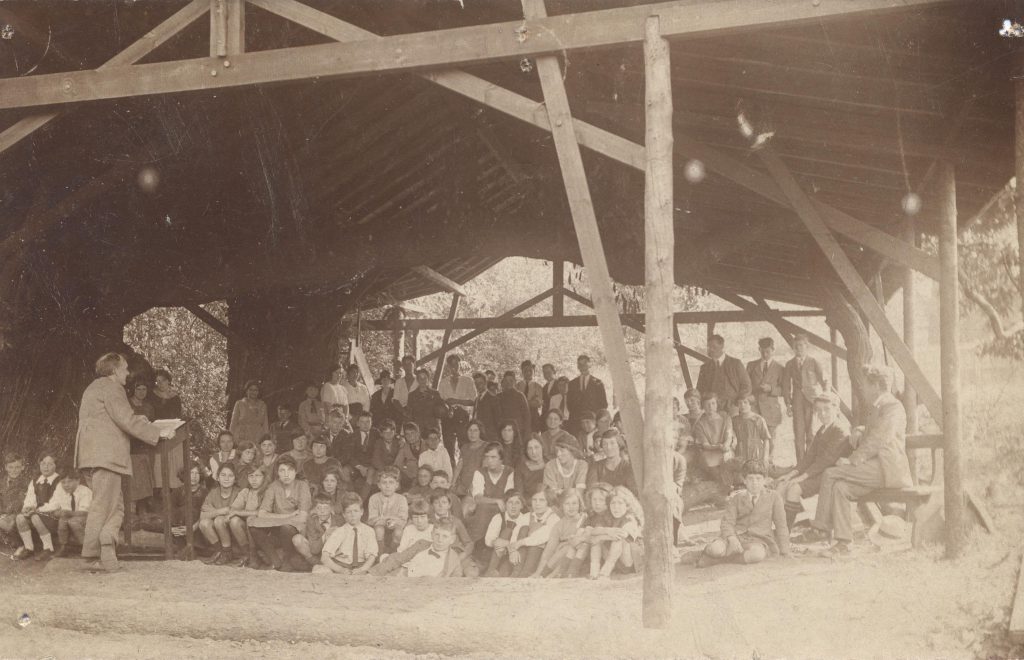
Squirrel Hall
1920 marked the retirement of Headmaster John Russell and the appointment of Joseph Wicksteed.
Wicksteed was committed to the value of open air education. In 1921, one of his first acts as Head was to design and build Squirrel Hall with staff and students. The building had no walls and consisted solely of a wooden roof suspended by tree trunks.

School Play
Drama and performances have always been a central part of student life at KAS. In 1912, the school play was Odin. If you look carefully, you can see the school motto “Ex Corde Vita” on the stage.

Outdoor Learning
Outdoor learning has always been a central part of the King Alfred School philosophy.
These photographs from 1914 capture children going for nature walks and searching ponds for specimens. After spending time outdoors, they would learn about the they found in lectures.

Squirrel Hall
1920 marked the retirement of Headmaster John Russell and the appointment of Joseph Wicksteed.
Wicksteed was committed to the value of open air education. In 1921, one of his first acts as Head was to design and build Squirrel Hall with staff and students. The building had no walls and consisted solely of a wooden roof suspended by tree trunks.


